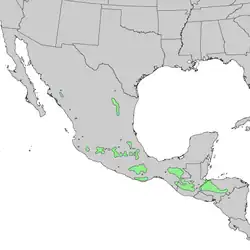Pinus pseudostrobus
| Pinus pseudostrobus | |
|---|---|
 | |
| var. apulcensis in cultivation | |
| Scientific classification | |
| Kingdom: | Plantae |
| Clade: | Tracheophytes |
| Clade: | Gymnospermae |
| Division: | Pinophyta |
| Class: | Pinopsida |
| Order: | Pinales |
| Family: | Pinaceae |
| Genus: | Pinus |
| Subgenus: | P. subg. Pinus |
| Section: | P. sect. Trifoliae |
| Subsection: | P. subsect. Ponderosae |
| Species: | P. pseudostrobus |
| Binomial name | |
| Pinus pseudostrobus | |
 | |
| Natural range of Pinus pseudostrobus. Pinus pseudostrobus is also found in El Salvador.[2] | |
| Synonyms | |
| Pinus astecaensis Roezl ex Gordon[4] Pinus coatepecensis (Martínez)Gaussen[3] Pinus estevezii (Martínez) J.P.Perry[3] Pinus nubicola J.P.Perry[3] Pinus oaxana Mirov[4] Pinus yecorensis Debreczy & I.Ràcz | |
Pinus pseudostrobus, known in English as the smooth-bark Mexican pine and in Spanish as chamite or pacingo, is a tree found in forests of Mexico and Central America.[1][2][6] It is 8 to 25 m tall with a dense and round top.It is threatened by logging and wood harvesting.[1] The bark is brown and fissured and smooth when young. It is subject to ex situ conservation.[1] It grows at altitudes between 850 and 3250 m. from 26° to 15° north latitude, from Sinaloa, Mexico to Nicaragua and Honduras. It occurs within a rainfall regime that rains mostly in summer.
In some forested areas like southern Nuevo León Pinus pseudostrobus is the tree with largest volume per hectare.[7]
English botanist John Lindley described the species in 1839. It is divided into Pinus pseudostrobus var.apulcensis (Lindl.)Shaw (Apulco pine), Pinus pseudostrobus f.protuberans Martínez and Pinus pseudostrobus var.pseudostrobus.[2][6]
It has been introduced in New Zealand near sea level and has done well.
-
.jpg) Male cones at San Francisco Botanical Garden
Male cones at San Francisco Botanical Garden -
 Pinus pseudostrobus, Cerro Pelón, Mexico
Pinus pseudostrobus, Cerro Pelón, Mexico
References
- ^ a b c d Farjon, A. (2013). "Pinus pseudostrobus". IUCN Red List of Threatened Species. 2013: e.T42404A2977667. doi:10.2305/IUCN.UK.2013-1.RLTS.T42404A2977667.en. Retrieved 16 November 2021.
- ^ a b c "Pinus pseudostrobus". Plants of the World Online. Retrieved 31 March 2021.
- ^ a b c d e f g h "Pinus pseudostrobus var.pseudostrobus". Plants of the World Online. Retrieved 2 April 2021.
- ^ a b c "Pinus pseudostrobus var.apulcensis". Plants of the World Online. Retrieved 2 April 2021.
- ^ "Pinus pseudostrobus f.protuberans". Plants of the World Online. Retrieved 4 April 2021.
- ^ a b "Pinus pseudostrobus". iNaturalist. Retrieved 31 March 2021.
- ^ Bautista Cruz, Angelina; González Cubas, Rigoberto; Treviño Garza, Eduardo Javier; Yerena Yamallel, José Israe; Rodríguez, Eduardo Alanís; Aguirre Calderón, Oscar Alberto (2022). "Modelación de la biomasa aérea en bosques templados subtropicales secos en el noreste de México" [Modeling of aerial biomass in dry subtropical temperate forests in northeastern Mexico]. Bosque (in Spanish). 43 (3): 243–251. doi:10.4067/S0717-92002022000300243.
